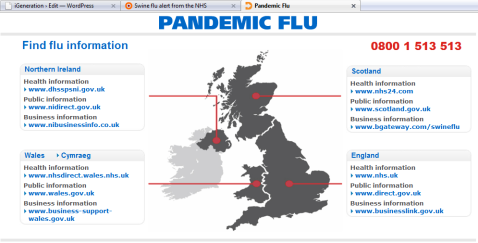England rolls out online flu pandemic service; Crashes after 8 minutes

The UK Government has rolled out the National Pandemic Flu Service in England today. Scotland, Northern Ireland and Wales have decided to opt out of the service as demands in numbers are significantly less than that of England.
According to the BBC, the UK may have over 100,000 cases of H1N1 infection along with roughly 30 deaths as a result. The US is reported to have 40,000 cases with over 250 deaths. But because the flu pandemic has spread so far and wide, it is difficult to determine whether someone's death is a direct result from swine flu, or whether the figures and statistics are accurate. There are simply too many cases and not enough resources being spent on data collection; some would say at least governments have their priorities right.
The National Pandemic Flu Service will be primarily a web based service, alongside a call center which will not be operated by health staff or qualified professionals to allow an "ease of burden on the NHS". It will act as a checklist service that algorithmically determines whether your symptoms are severe enough to require Tamiflu, the main anti-viral drug used to combat the illness.
If you are "successful", you will be given an authorisation code which, when taken to a pharmacy, will allow you -- or, more appropriately, a "flu friend" -- to collect the anti-virals on your behalf.
The flu service will have the capacity to handle 200,000 calls a day, which is vastly more than what NHS Direct, the UK's health advice service, is receiving.
At present it seems that every week the figures of those suffering from swine flu is roughly doubling. With 100,000 new cases being reported in England and Scotland this past week, the estimated figures show there could be around 160,000 cases now.
Prevention and containment are no longer viable solutions; treatment is the only option available to countries which have surpassed a level of infected persons. If this trend continues, maybe to 200,000 or more, will this flu service handle the numbers? Will the infrastructure hold out or will the phone lines be jammed with people trying to get through?
Before the site went live
Considering the primary way of accessing the service is through the Internet, questions will surely arise over the support system of the networks. With this new web service which went live a short while ago, there will no doubt be an initial surge to access the site. Whether the infrastructure can support so many people accessing the site all at once, we will see, but I wouldn't count on it.Just after the site went live
Only 8 minutes after it initially launched, the website crashed. With the number of people trying to access the site all in one go, the site couldn't cope with the number of requests.Also, the decision to generate an authorisation code to collect the anti-viral drugs has been seen in a positive light. Yet when the code is generated and a local pharmacy is also generated, from where you can get the drugs, this could be anywhere within the county you live in and not necessarily the one down the road or around the corner.
Even though this service is considered "rushed", it was still deemed important to go live as soon as it was completed. There are, however, still quite a number of back-end infrastructure issues to work on to enable the site to keep running, even when the systems are overloaded, and other bugs are ironed out such as the aforementioned generated pharmacy details.
A photo identification card of the sufferer who requested the anti-viral drugs as well as the person going to collect it is needed to take back the Tamiflu drugs, in an attempt to ensure that the system cannot be abused by those trying to stockpile drugs.
What people mostly seem to misunderstand is that the anti-viral drugs only work if you are suffering from the virus. Taking it before you contract the virus is pointless and has absolutely no effect whatsoever.
Criticisms will be given from all angles today. The opposition political party will no doubt have some harsh words to say and critics will argue that the system isn't secure enough to prevent abuse from those aiming to fool the system to stockpile anti-virals. Technology journalists will also be picking fault with the service, as it is often in their nature to do so, but it seems from the reports coming out from London is that this site and service will be patched, fixed, mended and strengthened as it goes along.
A spokesperson at the UK Department of Health told me that the site had been "extensively tested" and will be "monitored closely to make sure as many people benefit from it as and when they need it".
The fact of the matter is, at least something is being done. The pandemic flu service went live at 3pm (British Summertime) today. The website is http://www.direct.gov.uk/pandemicflu.
